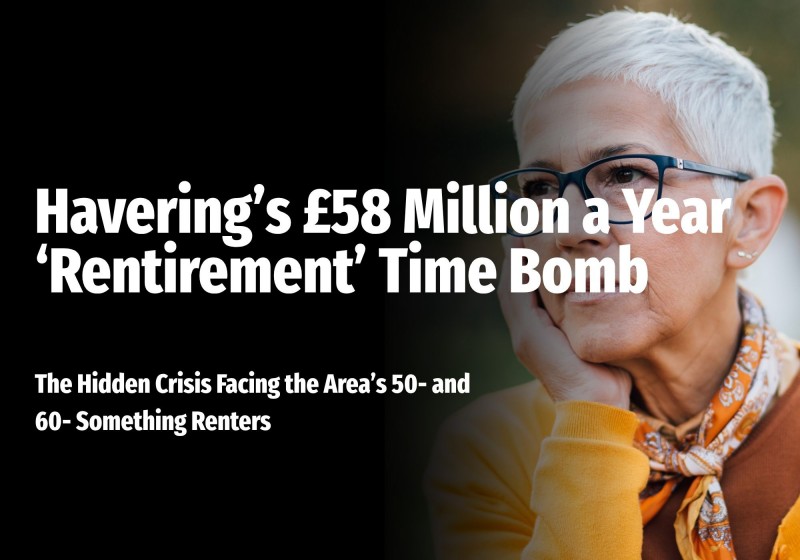
You’ve heard of retirement.
But what about ‘rentirement’?
It’s not a typo.
It's a ticking time bomb.
There are 3,314 households in Havering, aged between their early 50s and mid-60s, renting privately, not owning the Havering homes they live in. They're heading towards retirement age with no bricks and mortar, and the implications for them, their families, and Romford's social and economic infrastructure are vast.
Let’s call this what it is: a slow-moving crisis wrapped in letting agent “to let” boards and fuelled by decades of housing policy that prioritised homeownership above all else, leaving some behind.
What is ‘Rentirement’?
“Rentirement” is a blend of the words “rent” and “retirement,” referring to those entering their mature years still renting their homes rather than owning them. It’s not a lifestyle choice for most. It’s a result of economic reality.
Unlike traditional retirees who may have cleared their mortgages and can rely on relatively low housing costs, ‘rentirees’ are staring down the barrel of paying rent every single month for the rest of their lives. And with the Havering average rent at £1,478 per month, that’s no small chunk of their limited retirement income.
The numbers behind the problem
The average 50- to mid-60-something single person retiring in Romford (and Havering as a whole) is likely to rely on a monthly income of around £1,208. That includes the state pension of £756 per month, perhaps a modest private pension topping it up. This leaves very little breathing space once rent is paid.
Let us do the maths:
£1,478 monthly rent over 20 years = £354,720 per household.
Multiply that by 3,314 Havering renters aged 50-65 years, and we’re looking at a combined cost of £58,777,104 a year or £1.17 billion over the next 20 years.
That money comes either from these tenants' monthly income or savings or is subsidised by the taxpayer through housing support.
It’s not sustainable. And it’s not talked about enough.
Why are so many older Romford residents still renting?
Before I answer that, let’s be clear: this isn't just a 50-something problem.
Would it surprise you to know that 1,288 households in Havering, aged 65 and over, are still privately renting and spend £22.84 million a year on rent?
For many, it started decades ago.
Some never managed to pull together a deposit when house prices were rising. Others didn't earn enough to qualify for a mortgage. Some may have experienced divorce or life events that pulled the financial rug from under them. The dream of social housing faded when council homes were sold off in the 1980s, and waiting lists now stretch for years.
Owning never happened.
And now it's almost certainly too late.
Is this just a Romford issue?
No. It's a national one. Romford's (and Havering's) demographics with its ageing population, and reliance on private rentals without large scale local authority housing don’t help matters.
Renting is common in countries like Germany and the Netherlands, but retirement looks different there. Families often cascade wealth down through generations, and many renters in their 50s and 60s use their inheritance to eventually buy. That's not the norm here—not yet.
A fork in the road for younger generations?
Ironically, Romford's younger residents, those in their 30s and 40s, may find themselves in a stronger long-term position. Many are likely to inherit equity from their older OAP homeowner parents. When that wealth is passed down in the coming decades, some will invest in property, giving them the security their parents never had.
But for now, the current crop of ‘rentirees’ are heading into their later years with no safety net, and very little political attention.
What does this mean for Romford landlords?
If you are a buy-to-let landlord in Romford, this is not a doom story. It’s a demographic opportunity.
This group of older Romford renters isn’t going anywhere. They are long-term tenants. They want stability. They take care of their homes. And if treated fairly, they are more likely to stay for years.
But they also have limited means. As a landlord, it's also worth thinking long-term, offering fair rents, supporting stability, and recognising that older tenants are not high-risk. They are the backbone of many portfolios.
At the same time, demand for certain types of homes, particularly bungalows, will continue to rise. Yet builders aren’t constructing them. Why? Because bungalows require more land, and land equals higher costs. A three-bedroom house can be stacked upwards. A bungalow cannot.
This imbalance between demand and supply will only further drive prices (and rents). So, landlords holding bungalows in Romford are in a strong position.
‘Rentirement’: Freedom or Fragility?
There’s another side to the ‘rentirement’ coin that deserves mentioning. For some Romford retirees, renting offers flexibility. No home repairs, no responsibility for roof leaks or boilers breaking. The option to move closer to family or try a new area.
Some retirees choose to rent, sell their property, and unlock capital to enjoy retirement. But they are the exception, not the rule. The majority of Romford's ‘rentirees’ didn’t plan it. They fell into it.
And there are things they must consider:
- Rental inflation: Rents are unlikely to go down.
- Security: A landlord may decide to sell. That’s stress no retiree should face.
- Personalisation: Renting means limits on making the space your own.
The question Romford needs to ask
What happens when more than 1 in 10 local retirees can't afford a roof over their heads without financial aid?
It’s time for councillors, housing associations, and local developers to face this head on. Romford (and Havering) needs a strategy for housing an ageing population who rent. Not just token gestures, but real planning:
- Incentives to build accessible single-storey homes
- Better long-term tenancy protections
- Encouragement of inheritance funded homeownership transitions
- Support schemes for older tenants
Final thoughts…
“Rentirement” isn’t a buzzword. It's the reality for hundreds in Romford and thousands across the UK.
Unless we address it now, that £1.17 billion over the next 20 yearsisn’t just a statistic. It’s a warning to the policymakers, to the landlords and to society.
Renting in your 20’s is a phase. Renting in your 40’s might be your future. But renting in your 70’s and 80’s … with no plan in place? That could be a problem.
And Romford cannot afford to ignore it.
